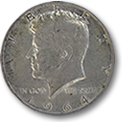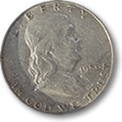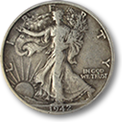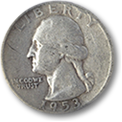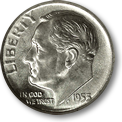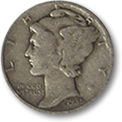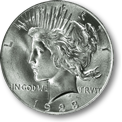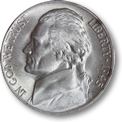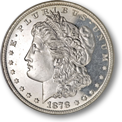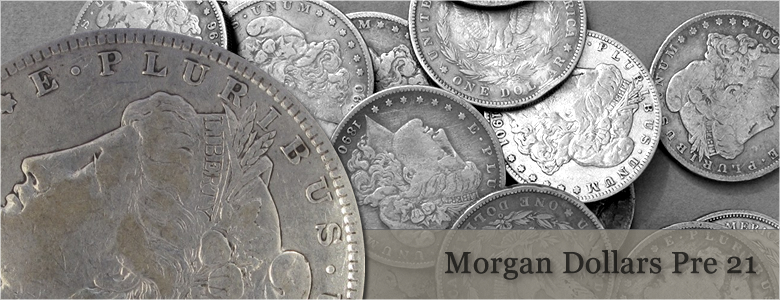
The History of the Silver Morgan Dollar
It was the year 1876. The director of the US Treasury Mint Department, Henry Richard Linderman, needed re-designs on our nation's coins. He contacted the Royal London Mint. C.W. Fremantle, the Deputy Master of the London Mint responded. Linderman had asked him to "find a first-class die-sinker", someone who would be willing to become an Assistant Engraver at the Philadelphia Mint Department. Fremantle wrote back to Linderman saying he had found a magnificent young engraver. Consequently, George Morgan, 30, came to this country to work for the Philadelphia Mint.Morgan would work under current Chief Mint Engraver, William Barber. He arrived on October 9, 1876. Starting out under a six month trial, he immediately signed up to become a student at the Pennsylvania Academy of Fine Arts. This would help him prepare for the creation of a new Lady Liberty head design. He obtained studies of Bald Eagles out in nature to prepare for the reverse design. He wanted Lady Liberty to reflect an American woman, rather that the Greek-style Goddess the originals were designed from. Morgan had an artistic friend named Thomas Eakins who suggested he use a Philadelphia woman by the name of Anna Willes Williams for his model. Williams sat for him on five occasions. When finished, he declared her profile portrait as "the most perfect I have ever seen."
His designs were intended for the silver half dollar. Previous to his arrival, in 1873, Congress had enacted what was known as the Fourth Coinage Act. This law was passed to effectively stop the bi-metallic standard in the United States by removing silver as our base metal for any coins. Before the passing of this act, silver could be taken to the Mint Department by anyone, from anywhere, and delivered to be changed into legal coinage for a very small fee. This system allowed bullion producers to have their silver struck into coinage even when the intrinsic value of the silver dollar was lower than its face value. This could be done for a profit, and caused flooding into the money supply. This resulted in inflationary pressures.
The Fourth Coinage Act worked to end the run of the silver dollar which at the time was a seated Lady Liberty, designed by Christian Gobrecht. The Act also served to provide competition to the Mexican trade-dollar which was widely used in the Orient. Bullion producers could now bring bullion into the Mint Department, and have it cast into bars and transformed into the new authorized trade dollars for a minuscule fee. Originally, trade dollars held the status of legal tender. In 1876 this status was later revoked. The revocation was designed to prevent bullion dealers from generating profits when silver values were low.
Initially these restrictions on no-cost coinage laid out in the Coinage Act met little resistance from the silver mining interests. However, that changed once the price of silver began to rapidly decline because of the ever-increasing mining. In western parts of the United States, protests began to pour in from manufacturers and bankers. Protests also came from farmers. These groups felt the increase in the money supply would actually serve to have a very positive influence on the economy. To combat the issue, 1873 "Free Silver" groups began to pop up in order to promote inflation of the dollar by demanding that silver once again be coined for free. They felt they had learned from experience from the "panic" in 1873 that had caused the original Coinage Act to be introduced into Congress.
And so, in 1876, Missouri democratic senator Richard P. Bland introduced a bill into the House of Representatives that would resume free coinage of the regular silver dollar, and Iowa republican senator William B. Allison added amendments on the bill that eliminated this provision while it was in the Senate. The Bill was passed in the fall. The Bill also allowed for the first time, the questionable practice of using paper silver certificates that represented a stored amount of silver.
Interestingly enough, the Bill was immediately vetoed. President Rutherford B. Hayes saw the veto overridden on February 28, 1878. This became known as the Bland-Allison Act and it required the Treasury to purchase from two to four million in silver monthly. It was to be changed into silver dollars at the previous gold/silver ratio of 16:1, making a gold ounce equal to sixteen ounces of silver.
By October of 1877 Linderman wrote a letter to Mint superintendent James Pollock asking him to:
"Instruct Mr. Morgan to prepare without delay, dies for a silver dollar with designs, inscriptions, and arrangement therof to be the same as the enclosed impression for the Half Dollar and numbered '2' substituting the words 'one dollar' in place of 'half dollar'."
Linderman then ordered Pollock to:
"Instruct Mr. Barber to prepare a reverse die for a dollar with a representation of an eagle as well as the inscriptions required by law. He will select whichever of his heads of Liberty he prefers for the obverse of the same."
Linderman now seemed to prefer the designs of Morgan above long-time aging and cantankerous-in-reputation, Chief Engraver Barber. He sent another letter to Pollock on February 21, 1878 stating:
"I have now to state for your information, that it is my intention, in the event of the silver bill now pending in Congress, becoming law, to request the approval by the Secretary of the Treasury, of the dies prepared by Mr. Morgan."
On March 11, only after the passage of the Bland-Allison Act, the acceptable coin strike was made. Adjustments to the press had been conducted and it was coined at 3:17 p.m. on a press in the Philadelphia Mint Department. This first Morgan Dollar was awarded to President Hayes. The second was given to the Treasury Secretary, John Sherman and one went to the Mint Director himself, Henry Linderman.
Linderman apparently had decided to bring the western Mint Departments into the order. This was to help them meet the new mandated monthly quota needed under the new Act. The Act had caused so much pressure for this Mint that they had stopped making any other coins, and were operating on over-time.
Linderman then sent orders out to Carson City and then San Francisco Mint Departments to spread the production out more evenly. Unfortunately, all dies were currently being prepared by the Philadelphia Mint Department and it seems the western Mint Departments did not have the die preparation equipment available at that time. This inevitably caused a delay. During production, Linderman found what he termed a "slight imperfection" in the dies.
Linderman wanted the reliefs reduced and he wanted to change the eight tail feathers on the eagle back to its original odd number--seven. A high relief setting tends to wear out the die stamps. On April 16, 1878 the new die stamps arrived at the western Mint Departments. In 1879, New Orleans Mint Department also began to strike this new dollar. The Denver Mint, founded in 1906, only struck the dollar for a single year-1921. There is no mint mark for those struck at the Philadelphia Mint, and the letters "CC" meant they were struck in Carson City, just as "S" meant San Francisco, "O" meant New Orleans and "D" stood for Denver.
To attend to the mandates of the Coinage Act of 1837, the metal in the dollars were made up of 90 percent silver and ten percent copper. They measured 38.1 millimeters or 1.50 inches in around and weighed 26.73 grams. Production for Morgan Dollars remained steady until Sherman's Silver Purchase Act of 1890.
In 1890 the Bland-Allison Act was repealed by former Treasury Secretary, and now Ohio senator, John Sherman. He authored this Silver Purchase Act. It passed on July 14, 1890. The Act mandated that the Treasury buy 4,500,000 troy ounces in silver. They had to do this every month. It required silver dollar production for only one more year.
The 140,000 kg of monthly production and silver purchases were believed by supporters to relieve the nation's farmers and interests in the silver mining industries in a manner that would result in an inflation that would help relieve the financial stress they were currently under. They believed large purchases of silver would raise the market price of silver, thus increasing profits. Even though the Act required large silver purchases, it only required coinage of 2,000,000 silver dollars per month and only until 1891. The Treasury already had surpluses of silver. So, in 1892, production of silver dollars began to drop sharply.
By 1892 the remaining silver was turned into half dollars, dimes and quarters. In the early part of 1893 industrial companies such as the Reading and the Philadelphia Railroads and the National Cordage Company announced bankruptcy. The resulting failures and bank runs that occurred became known as the "Panic of 1893." President Grover Cleveland believed the panic was caused by the Purchase Act. A special congressional session was called. This act was repealed on November 1, 1893.
In 1898 A Bill was again approved in Congress that required any left over bullion from the Sherman Silver Purchase Act get re-cast back into silver coinage, and production rose again. In 1904 these silver stocks were completely gone. All Mint Departments stopped producing the Morgan Dollar.
In 1918, the Pittman Act was introduced. This bill authorized the melting and then re-coining of millions of silver dollars. The re-coining process was again started and by 1921 the Morgan Dollar was produced for one more year. By the end of the year the conclusion of World War I had triggered the call for a "Peace Dollar," that was delivered into the circulation by the very end of that same year.
In early 1960 a large quantity of un-circulated Morgan Dollars was discovered to be available from the Treasury vaults. Amazed collectors realized some of the coins found were currently considered to be rare. People began to buy large quantities at face value as a result, and so the Treasury decided not to continue exchanging silver for the silver certificates. In early 1970 the Treasury held a sale of silver dollars from the Carson Mint. In 2006 Morgan Dollar reverse designs were used on a silver dollar that was issued in order to immortalize the aging San Francisco Mint Department building.
It remains interesting to see what impact our lobbyists, senators and acts of congress can have on our economy, our mintage runs and our daily use of coins. We seem to learn from experience and experimentation.
Our nation apparently has been largely shaped economically by the decisions made by Congress that relate to how and when our coins will be upgraded, dated and released. They also determine what our coins are made of and what values they hold.
A fascinating aside is the reason that caused the Pittman Act of 1918 that melted 350,000,000 silver dollars to become passed into law. The German government had convinced Great Britain's government that residents of conquered India who were holding the USA silver certificates that they wouldn't be exchanged for silver. This false story caused a run on British metal supplies. In some ways this is reminiscent of what is happening in the American government today. Obtaining the truth about different issues seems difficult. One party, backed by money interests, presents a bill to Congress and the other side shows why it can't and won't work, or why it does the opposite of what it is designed to do. This sort of confusion has a huge effect on the results of elections and the passing of bills into law.
Today moneyed interests have more voice in the public air and media waves than ever before in our nation's history. It is important for collectors to realize the importance of following the legislative processes in our nation, and using the collective voice of the business community to respond when needed. In a country based on equal representation and democracy, it is important for this to actually be true.








